4.5 TestNG 集成 HttpClient
首先将 TestNG 和 HttpClient 进行集成,然后进行 HTTP 接口自动化测试。
在 pom.xml 文件的 <dependencies> 标签中输入以下粗体部分内容:
<?xml version="1.0" encoding="UTF-8"?> <project xmlns="http://maven.apache.org/POM/4.0.0" xmlns:xsi="http://www.w3.org/2001/XMLSchema-instance" xsi:schemaLocation="http://maven.apache.org/POM/4.0.0 http://maven.apache.org/xsd/maven-4.0.0.xsd"> <modelVersion>4.0.0</modelVersion> <groupId>cn.edu.bjut</groupId> <artifactId>httpinterfacetest</artifactId> <version>1.0-SNAPSHOT</version> <dependencies> <dependency> <groupId>org.apache.httpcomponents</groupId> <artifactId>httpclient</artifactId> <version>4.5.9</version> </dependency> <dependency> <groupId>org.testng</groupId> <artifactId>testng</artifactId> <version>6.14.3</version> <scope>test</scope> </dependency> <dependency> <groupId>org.json</groupId> <artifactId>json</artifactId> <version>20180813</version> </dependency> <dependency> <groupId>org.dom4j</groupId> <artifactId>dom4j</artifactId> <version>2.1.1</version> </dependency> <dependency> <groupId>jaxen</groupId> <artifactId>jaxen</artifactId> <version>1.2.0</version> </dependency> </dependencies> </project>
保存 pom.xml 文件,这时 Maven 会自动下载依赖的 jar 包。这里添加了 4 个依赖。
①TestNG:自动化测试框架 TestNG 的依赖。
②JSON:用于处理 JSON 数据,在 RESTful POST 请求的请求体及响应体中均可使用。
③DOM4J:用于处理 XML 数据,在 SOAP 请求的请求体及响应体中均可使用。
④JAXEN:当 DOM4J 用 XPath 方式获取节点时需要依赖该 jar 包。
依赖 jar 包下载完成后,在工程(httpinterfacetest)上用鼠标右击,从弹出的快捷菜单中选择「TestNG → Convert to TestNG」选项,在工程中生成 testng.xml 文件。
4.5.1 RESTful 接口自动化测试
1.编写 GET 接口自动化测试用例

把 Test Class 重命名为 GetMobilePhoneTest,删除 GetMobilePhoneTest 中的内容,输入以下代码:
package cn.edu.bjut; import org.apache.http.client.methods.CloseableHttpResponse; import org.apache.http.client.methods.HttpGet; import org.apache.http.client.utils.URIBuilder; import org.apache.http.impl.client.CloseableHttpClient; import org.apache.http.impl.client.HttpClients; import org.apache.http.util.EntityUtils; import org.testng.Assert; import org.testng.annotations.AfterClass; import org.testng.annotations.BeforeClass; import org.testng.annotations.Test; import java.net.URI; public class GetMobilePhoneTest { private CloseableHttpClient client; private CloseableHttpResponse response; @BeforeClass public void init() { client = HttpClients.createDefault(); } @Test public void testCase1() { Assert.assertEquals("{"brand":"Apple","model":"iPhone 6S","os":"IOS"}", sendHttpGetRequest(client, "iPhone 6S")); } @Test public void testCase2() { Assert.assertEquals("", sendHttpGetRequest(client, "")); } @Test public void testCase3() { Assert.assertEquals("", sendHttpGetRequest(client, null)); } @Test public void testCase4() { Assert.assertEquals("", sendHttpGetRequest(client, "01234567890123456789012345678901234567890123456789")); } @AfterClass public void clear() { try { response.close(); client.close(); } catch (Exception e) { e.printStackTrace(); } } //定义一个私有的方法,用来发送Get请求 private String sendHttpGetRequest(CloseableHttpClient client, String model) { String result = null; try { URI uri = new URIBuilder().setScheme("http").setHost("localhost").setPort(8080).setPath("/mobilePhone") .setParameter("model", model).build(); response = client.execute(new HttpGet(uri)); result = EntityUtils.toString(response.getEntity()); } catch (Exception e) { e.printStackTrace(); } return result; } }
修改 testng.xml 文件,在<;test>;标签中新增以下粗体部分内容:

保存所做的修改,在 testng.xml 上用鼠标右击,从弹出的快捷菜单中选择「Run As → TestNG Suite」选项,可以看到如图 4-2 所示的测试报告。

下面对运行结果进行说明。
①init()方法初始化了一个 HTTP 客户端,并在 sendHttpGetRequest()方法中使用,最后在 clear()方法中关闭。
② 将构造 URI、发送 GET 请求和转换服务器响应等过程封装在 sendHttpGetRequest()方法中,通过传递 HTTP 客户端和参数来使用该方法。
③ 在 clear()方法中对 HTTP 客户端和服务器响应进行关闭操作,在操作过程中可能出现异常,所以需要对异常进行捕获和处理。
2.POST 接口自动化测试用例编写
在 cn.edu.bjut.httpinterfacetest Package 中创建名为 SaveMobilePhoneTest 的 Class,在 SaveMobilePhoneTest 中输入以下内容:
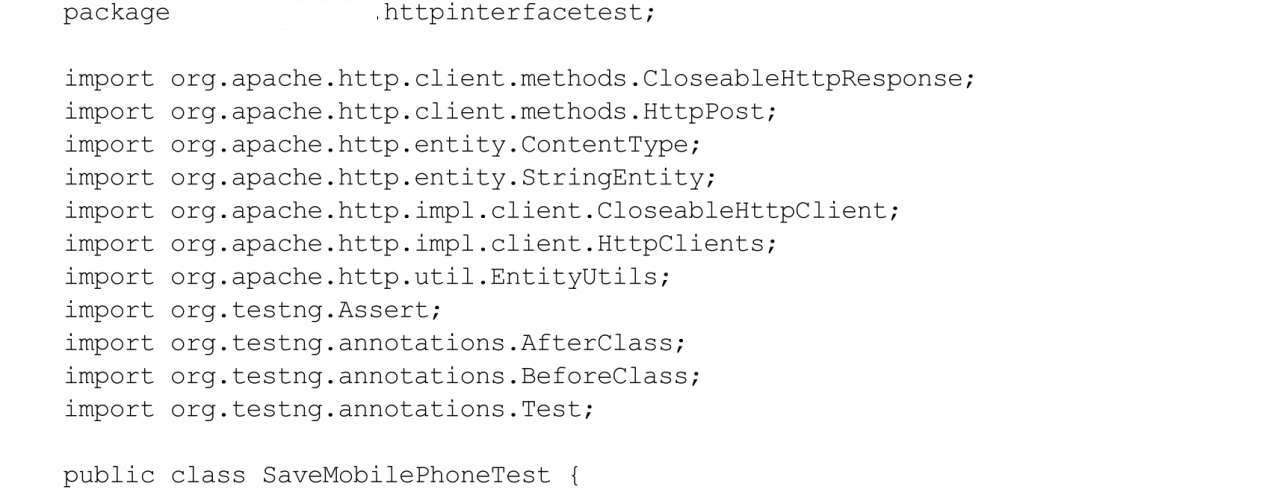

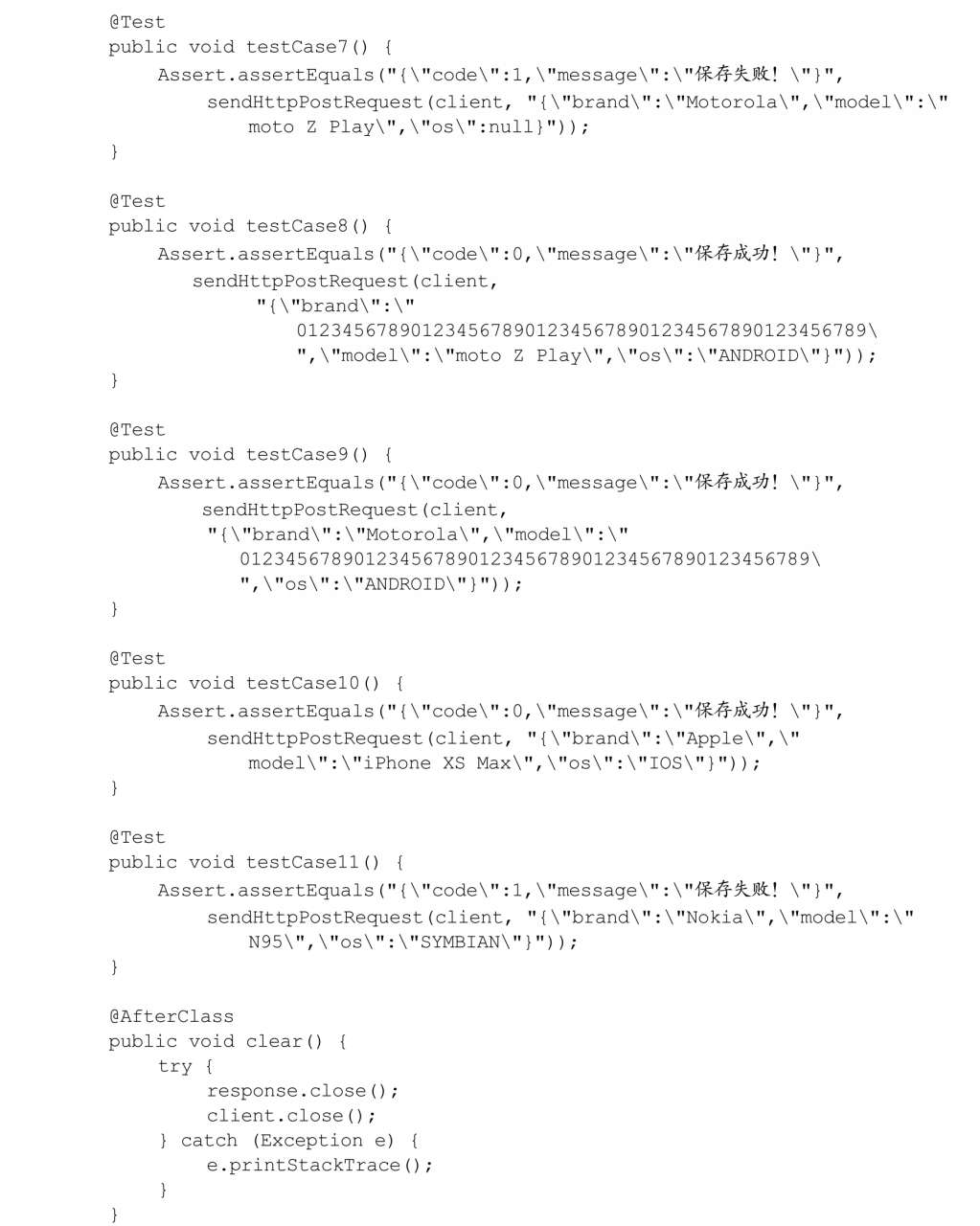

修改 testng.xml 文件,修改<;class>;标签中的 name 属性值,见以下粗体部分内容:

保存所做的修改,在 testng.xml 上用鼠标右击,从弹出的快捷菜单中选择「Run As → TestNG Suite」选项,然后查看测试报告,如图 4-3 所示。

图 4-3
下面对运行结果进行说明。
① 整体思路和上一个示例一致,只是将 sendHttpGetRequest()方法改成了 sendHttpPostRequest()方法,具体的实现都封装到了 sendHttpPostRequest()方法中。
② 从测试报告可以看出,有 7 个测试用例执行失败了,这时我们可以查看失败原因,以 testCase11 为例,单击「testCase11」,如图 4-4 所示。
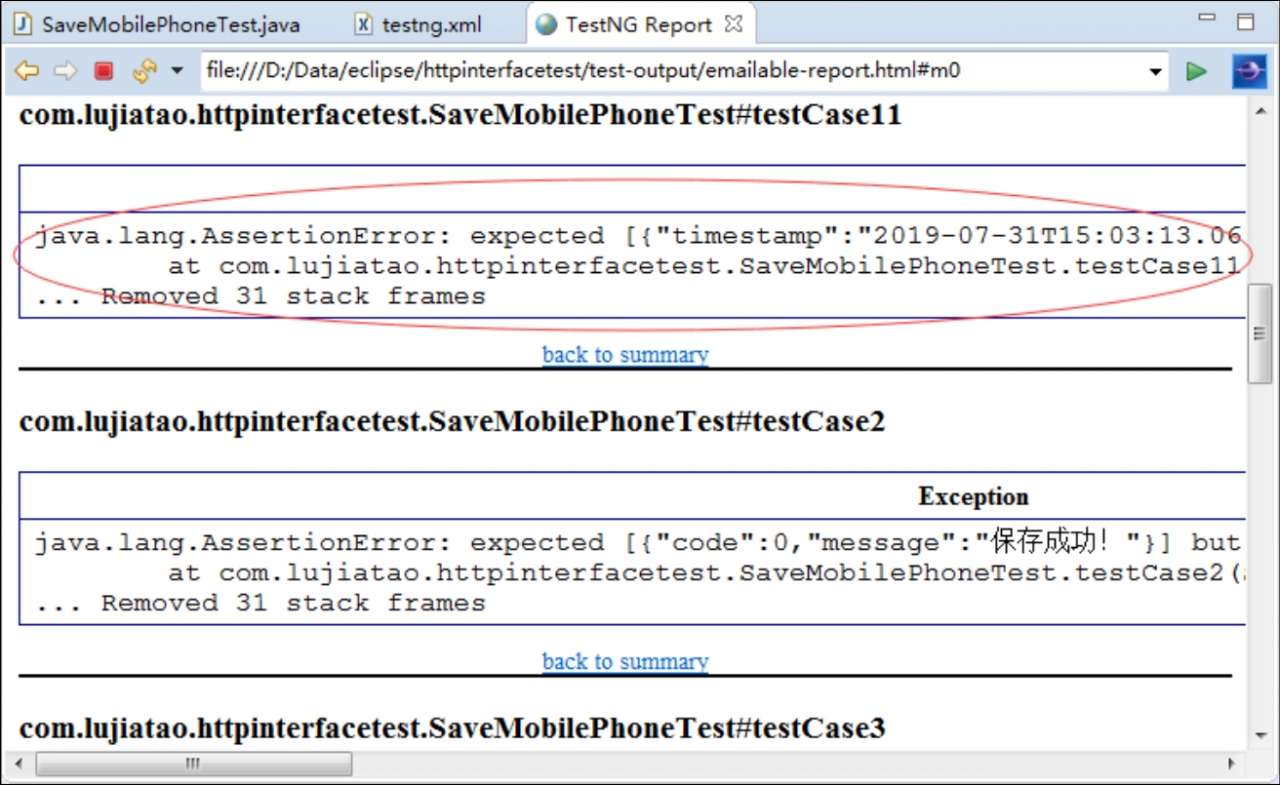
图 4-4
复制 expected 后的方括号中的内容:

可以看到服务器返回了 500 错误,提示没有「SYMBIAN」这个枚举,这里表明了待测程序设计不够严谨。待测程序没有对入参进行校验,导致不能返回友好的提示,而是直接返回了服务器 500 错误。
实际项目中,自动化测试用例执行失败后,通过对结果进行分析,在确认失败原因为待测程序的缺陷时,就应该将缺陷提交给开发人员。
3.简化自动化测试用例
上例中有 11 个自动化测试用例,但通过观察可以发现入参和期望值很相似,因此代码看上去很冗余,有没有简化的方法呢?答案是肯定的。第 3 章曾介绍过数据分离,这里就派上用场了。删除 SaveMobilePhoneTest 中的内容,输入以下内容:

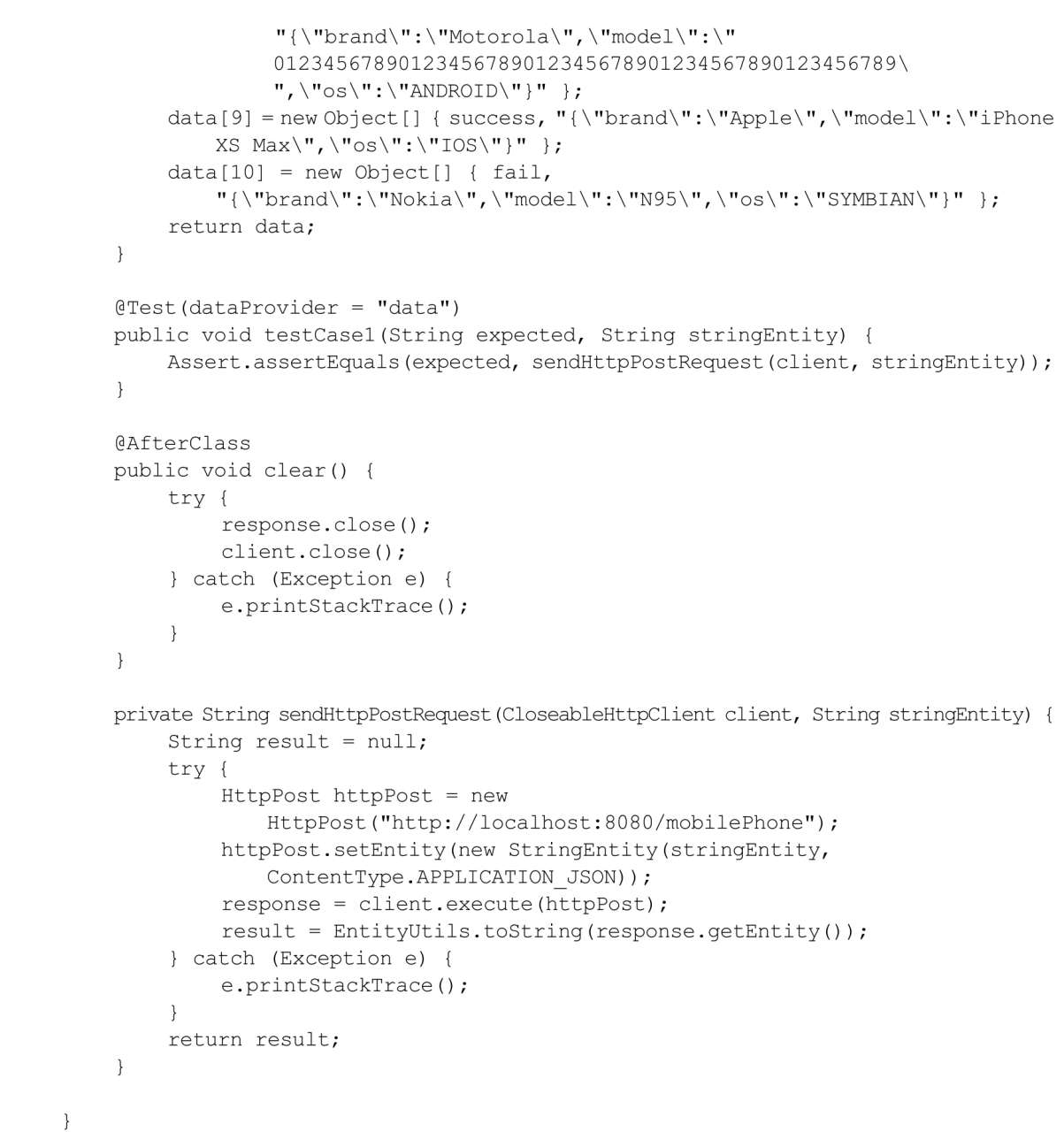
保存代码,选择「Run As → TestNG Suite」选项,测试报告如图 4-5 所示。
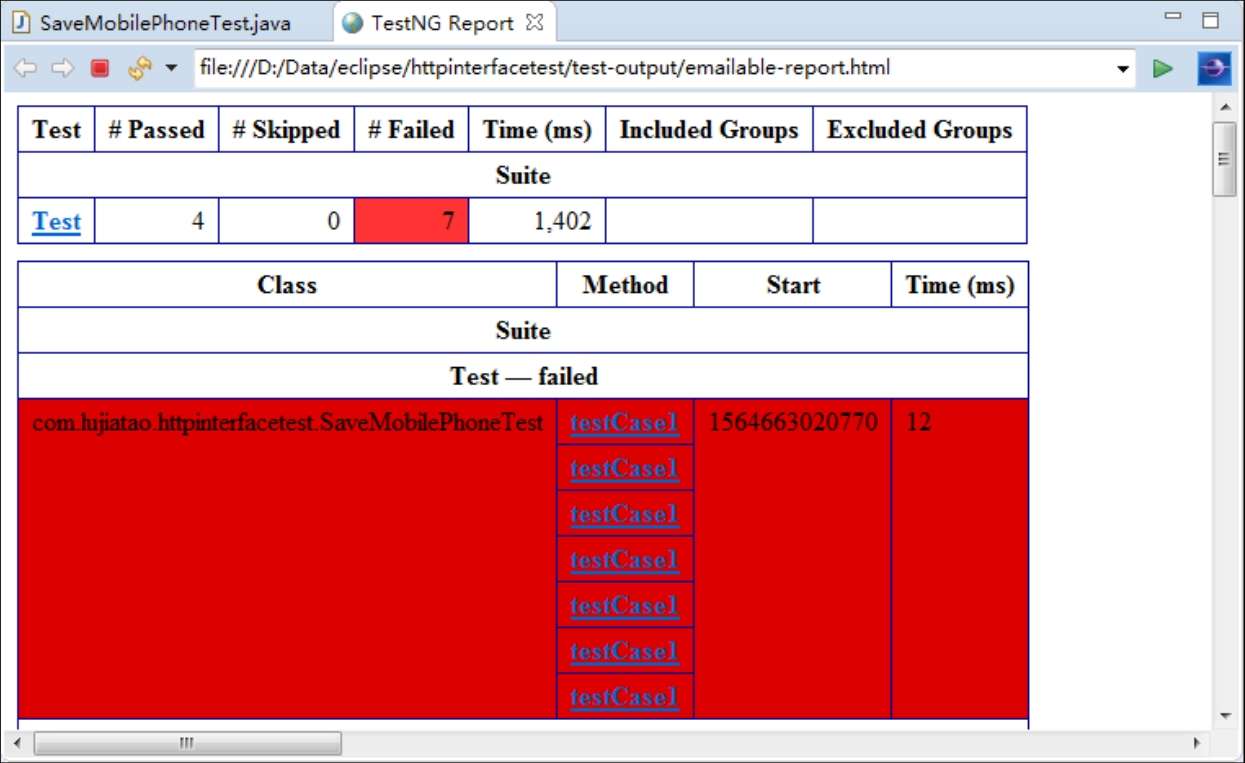
图 4-5
这里使用了@DataProvider 注解修饰一个方法,该方法用于提供测试数据,测试数据包括期望值和请求的实体字符串。
4.解析 JSON 字符串
RESTful 接口通过 JSON 传输数据,以上的例子我们都将 JSON 字符串当作「一般字符串」对待了,实际上可以通过对 JSON 字符串的解析进行更细粒度的控制。作为示例讲解,这里删除了 testCase2~testCase11,仅保留 testCase1:
package cn.edu.bjut; import org.apache.http.client.methods.CloseableHttpResponse; import org.apache.http.client.methods.HttpPost; import org.apache.http.entity.ContentType; import org.apache.http.entity.StringEntity; import org.apache.http.impl.client.CloseableHttpClient; import org.apache.http.impl.client.HttpClients; import org.apache.http.util.EntityUtils; import org.json.JSONObject; import org.testng.Assert; import org.testng.annotations.AfterClass; import org.testng.annotations.BeforeClass; import org.testng.annotations.Test; public class SaveMobilePhoneTest { private CloseableHttpClient client; private CloseableHttpResponse response; @BeforeClass public void init() { client = HttpClients.createDefault(); } @Test public void testCase1() { JSONObject expected = new JSONObject().put("code", 0).put("message", "保存成功!"); JSONObject stringEntity = new JSONObject().put("brand", "Motorola").put("model", "moto Z Play").put("os", "ANDROID"); JSONObject actual = sendHttpPostRequest(client, stringEntity.toString()); if (!(expected.get("code") == actual.get("code")) || !(expected.get("message").equals(actual.get("message")))) { Assert.fail("失败!"); } } @AfterClass public void clear() { try { response.close(); client.close(); } catch (Exception e) { e.printStackTrace(); } } private JSONObject sendHttpPostRequest(CloseableHttpClient client, String stringEntity) { JSONObject result = null; try { HttpPost httpPost = new HttpPost("http://localhost:8080/mobilePhone"); httpPost.setEntity(new StringEntity(stringEntity, ContentType.APPLICATION_JSON)); response = client.execute(httpPost); result = new JSONObject(EntityUtils.toString(response.getEntity())); } catch (Exception e) { e.printStackTrace(); } return result; } }
在 testCase1 中,将预期结果、入参和实际结果都用 JSONObject 对象表示,包括断言也是通过操作 JSONObject 对象完成的,整个过程看不到「糟心」的字符串。这样做的好处是将 RESTful 请求的请求体和响应体完全「JSON」化,便于进一步封装,并且与字符串也实现了「解耦」。
4.5.2 SOAP 接口自动化测试
1.自动化测试用例编写
在 cn.edu.bjut.httpinterfacetest Package 中创建名为 GetMobilePhoneSoapTest 的 Class,在 GetMobilePhoneSoapTest 中输入以下内容:

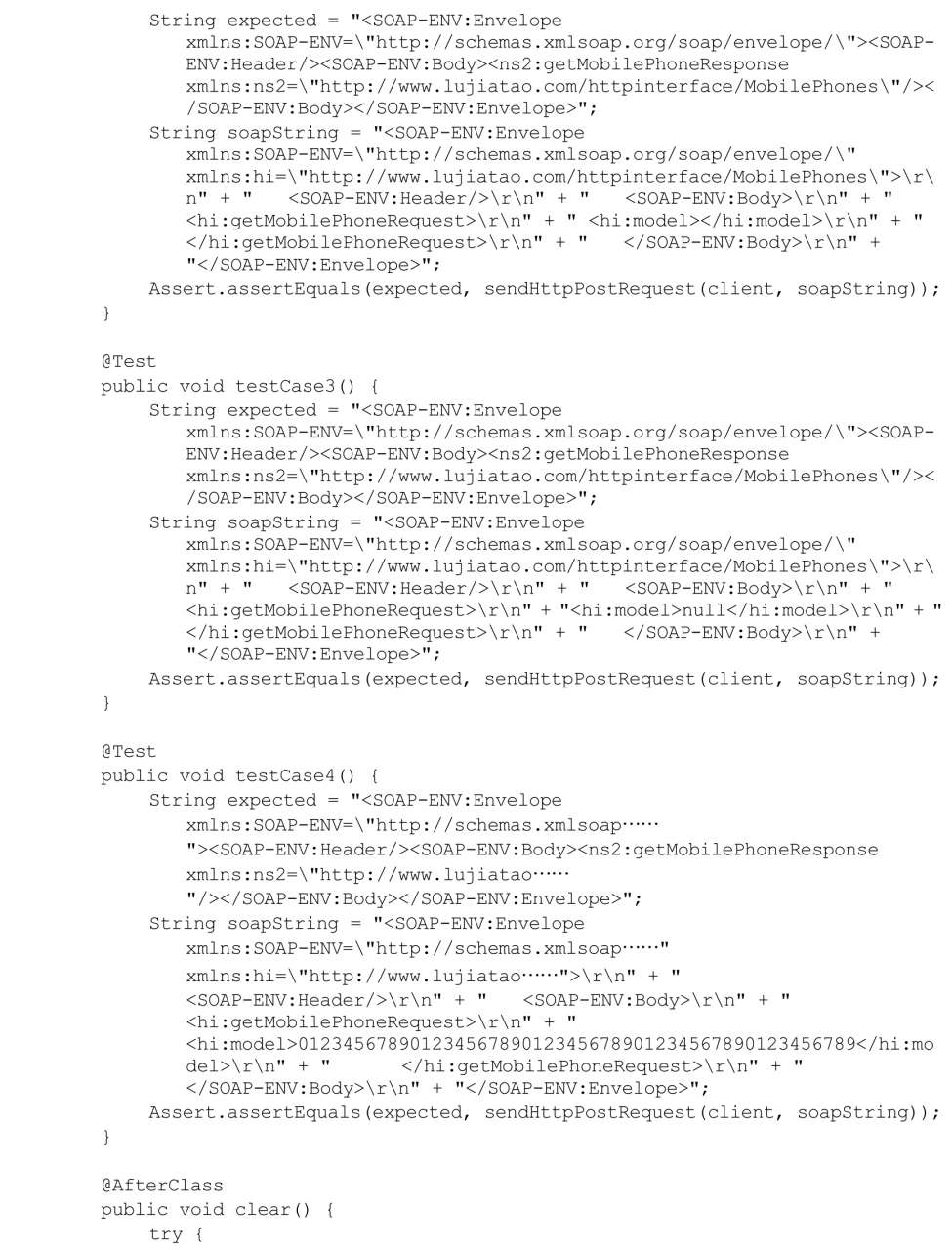
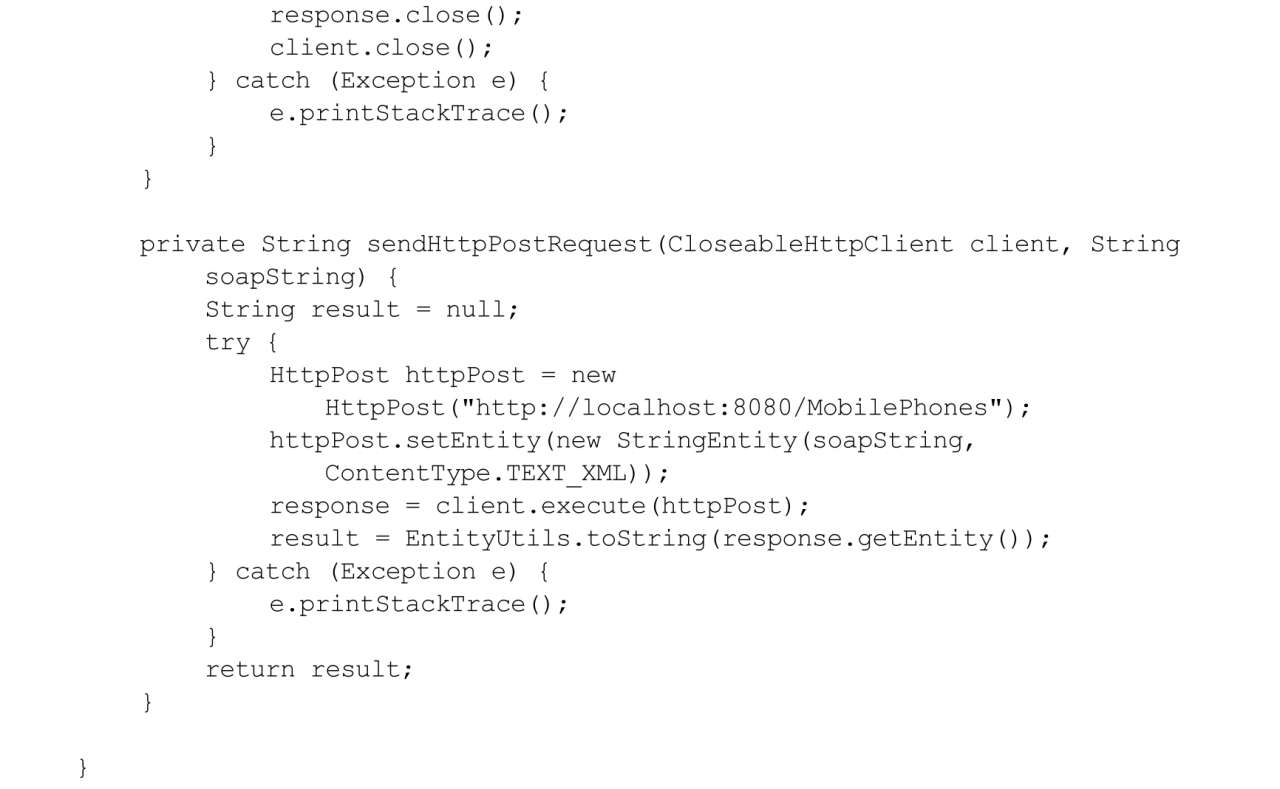
修改 testng.xml 文件,修改<;class>;标签中的 name 属性值,见以下粗体部分内容:

保存所做的修改,在 testng.xml 上用鼠标右击,从弹出的快捷菜单中选择「Run As → TestNG Suite」选项,测试报告如图 4-6 所示。

图 4-6
测试用例均通过测试,与预期一致。
2.解析 XML 字符串
直接处理 XML 字符串虽然能解决问题,但是代码可读性很差。这里使用 DOM4J 处理 XML 字符串。作为示例讲解,这里仅保留了 testCase1:
下面对代码进行说明。
GetMobilePhoneSoapTest.java

import java.util.HashMap; import java.util.Map; import org.apache.http.client.methods.CloseableHttpResponse; import org.apache.http.client.methods.HttpPost; import org.apache.http.entity.ContentType; import org.apache.http.entity.StringEntity; import org.apache.http.impl.client.CloseableHttpClient; import org.apache.http.impl.client.HttpClients; import org.apache.http.util.EntityUtils; import org.dom4j.Document; import org.dom4j.DocumentHelper; import org.dom4j.Element; import org.dom4j.XPath; import org.testng.Assert; import org.testng.annotations.AfterClass; import org.testng.annotations.BeforeClass; import org.testng.annotations.Test; public class GetMobilePhoneSoapTest { private CloseableHttpClient client; private CloseableHttpResponse response; @BeforeClass public void init() { client = HttpClients.createDefault(); } @Test public void testCase1() { // 构建期望XML Document expected = DocumentHelper.createDocument(); Element root = expected.addElement("SOAP-ENV:Envelope").addAttribute("xmlns:SOAP-ENV", "http://schemas.xmlsoap.org/soap/envelope/"); root.addNamespace("SOAP-ENV", "http://schemas.xmlsoap.org/soap/envelope/"); root.addElement("SOAP-ENV:Header"); Element body = root.addElement("SOAP-ENV:Body"); Element node = body.addNamespace("ns2", "http://www.lujiatao.com/httpinterface/MobilePhones") .addElement("ns2:getMobilePhoneResponse") .addAttribute("xmlns:ns2", "http://www.lujiatao.com/httpinterface/MobilePhones"); Element nodeChild = node.addElement("ns2:mobilePhone"); nodeChild.addElement("ns2:brand").addText("Apple"); nodeChild.addElement("ns2:model").addText("iPhone 6S"); nodeChild.addElement("ns2:os").addText("IOS"); // 构建期望XML对应的XPath Map<String, String> xmlMap = new HashMap<>(); xmlMap.put("ns2", "http://www.lujiatao.com/httpinterface/MobilePhones"); XPath xPath1 = expected.createXPath("//ns2:brand"); XPath xPath2 = expected.createXPath("//ns2:model"); XPath xPath3 = expected.createXPath("//ns2:os"); xPath1.setNamespaceURIs(xmlMap); xPath2.setNamespaceURIs(xmlMap); xPath3.setNamespaceURIs(xmlMap); // 构建入参XML Document soapString = DocumentHelper.createDocument(); Element root2 = soapString.addElement("SOAP-ENV:Envelope") .addAttribute("xmlns:SOAP-ENV", "http://schemas.xmlsoap.org/soap/envelope/") .addAttribute("xmlns:hi", "http://www.lujiatao.com/httpinterface/MobilePhones"); root2.addNamespace("SOAP-ENV", "http://schemas.xmlsoap.org/soap/envelope/"); root2.addNamespace("hi", "http://www.lujiatao.com/httpinterface/MobilePhones"); root2.addElement("SOAP-ENV:Header"); Element body2 = root2.addElement("SOAP-ENV:Body"); Element node2 = body2.addElement("hi:getMobilePhoneRequest"); node2.addElement("hi:model").addText("iPhone 6S"); // 接收响应XML并断言 Document actual = sendHttpPostRequest(client, soapString.asXML()); if (!(xPath1.selectSingleNode(expected).getText().equals(xPath1.selectSingleNode(actual).getText())) || !(xPath2.selectSingleNode(expected).getText().equals(xPath2.selectSingleNode(actual).getText())) || !(xPath3.selectSingleNode(expected).getText().equals(xPath3.selectSingleNode(actual).getText()))) { Assert.fail("失败!"); } } @AfterClass public void clear() { try { response.close(); client.close(); } catch (Exception e) { e.printStackTrace(); } } private Document sendHttpPostRequest(CloseableHttpClient client, String soapString) { Document result = null; try { HttpPost httpPost = new HttpPost("http://localhost:8080/MobilePhones"); httpPost.setEntity(new StringEntity(soapString, ContentType.TEXT_XML)); response = client.execute(httpPost); result = DocumentHelper.parseText(EntityUtils.toString(response.getEntity())); } catch (Exception e) { e.printStackTrace(); } return result; } }
① 使用 DOM4J 中的 API 构建期望值,实际上一个是 Document 对象。
② 后续断言会使用 XPath 方式查找期望值和实际值中的指定数据,因此这里先构建 XPath。
③ 使用 DOM4J 中的 API 构建入参。
④ 首先接收实际值(也是一个 Document 对象),然后通过 XPath 获得节点,最后通过对节点的文本进行比较完成断言。
